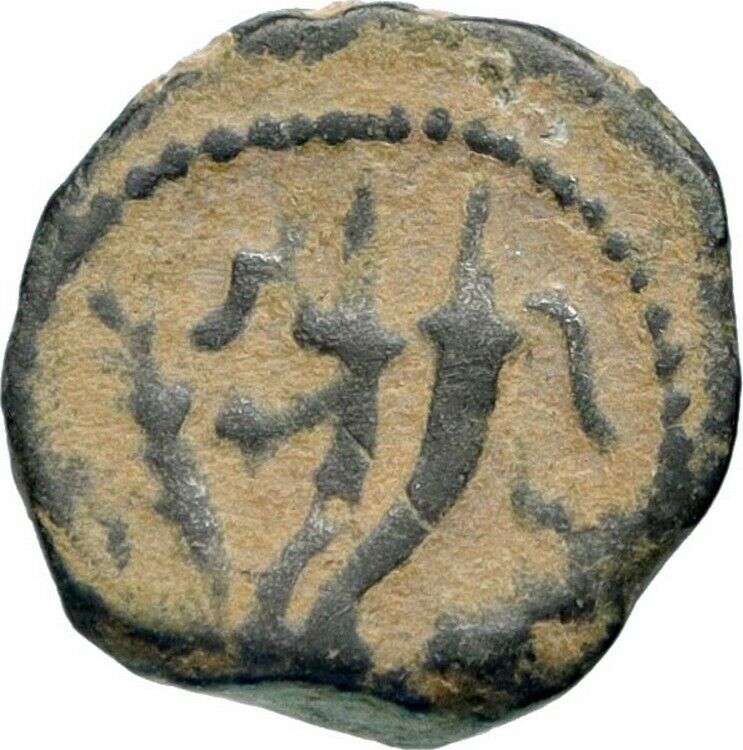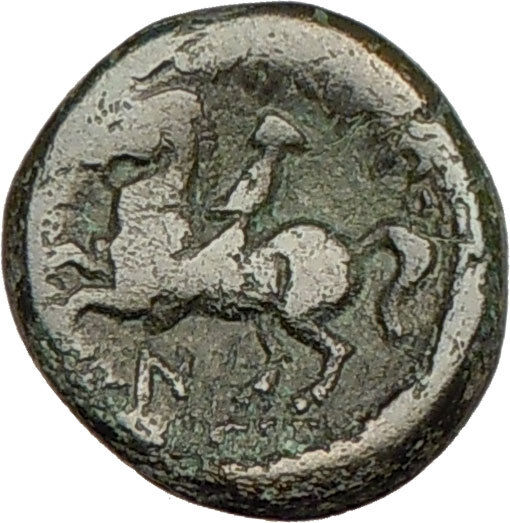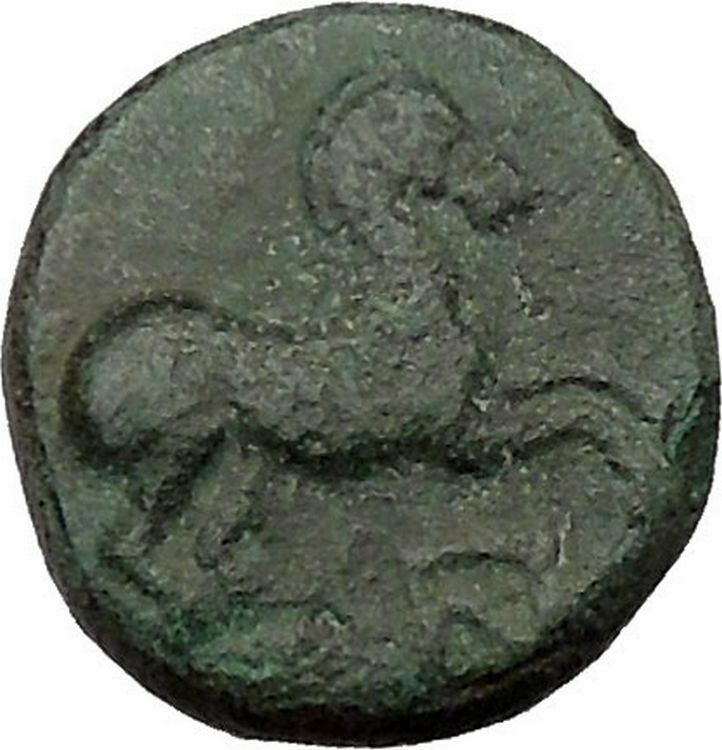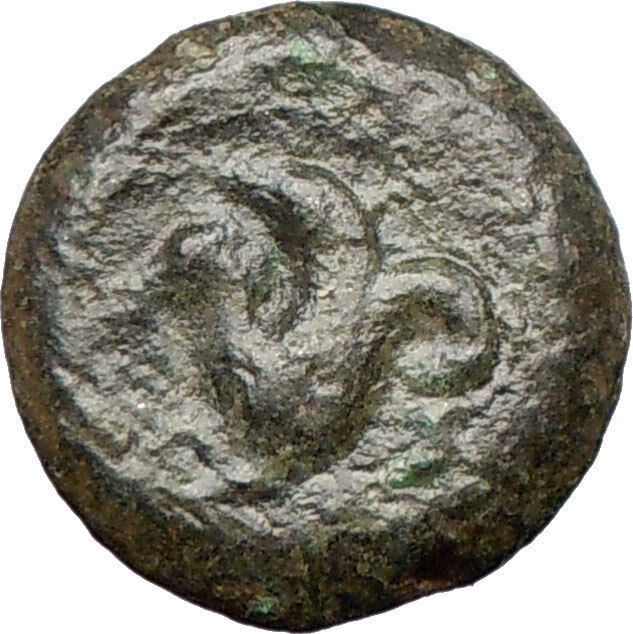|
Greek city of
Larissa Kremaste
<=”” font=”” color=”#000000″>
in
<=”” font=”” color=”#000000″>
Thessaly
Bronze Chalkous 14mm (2.26 grams) Struck 302-286 B.C.
Reference: HGC 4, 16; Rogers 316-318; Moustaka 166; SNG Copenhagen 152
Laureate head of the nymph Larissa to right, with necklace and earring.
ΛΑΡΙ, Harpa to right; Phrygian helmet to left.
Situated in the south of Thessaly, Larissa Kremaste was built
on a height, hence its name. It was taken by Demetrios Poliorketes in 302 B.C.,
during his invasion of Thessaly. The myth goes that Achilles, the tragic hero of
the Trojan war was born in the city and ruled a port of it’s dominions. Larissa
Kremaste was also the city that Perseus visited on his exile from Argos. Thetis
was the mother of Achilles, who is shown on coins from the city to be delivering
weapons to him that were forged by the smith god, Hephaistos.
You are bidding on the exact
item pictured, provided with a Certificate of Authenticity and Lifetime
Guarantee of Authenticity.
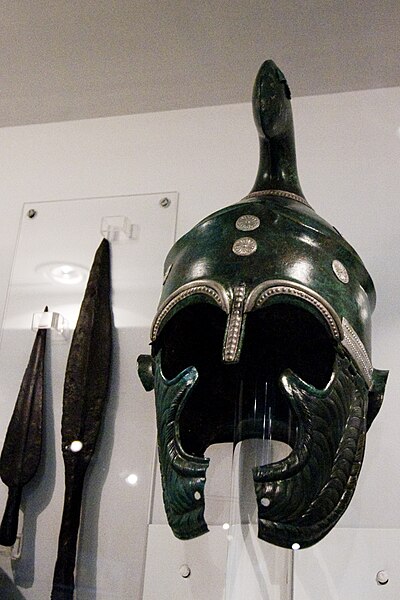
The
Phrygian helmet, also known as the Thracian helmet,was a type of
helmet that originated in
Classical Greece
and was widely use in
Thrace
,
Dacia
,
Magna Graecia
and
the
Hellenistic
world
until
well into the
Roman Empire
.
The Phrygian helmet was worn by
Macedonian
cavalry
in King
Philip
‘s day but
his son
Alexander
is said
to have preferred the open-faced
Boeotian helmet
for
his cavalry, as recommended by
Xenophon
The royal
burial in the
Vergina
Tomb
contained a helmet which was a variation on the Phrygian type, exceptionally
made of iron, this would support its use by cavalry. The Phrygian helmet is
prominently worn in representations of the infantry of Alexander the Great’s
army, such on the contemporary
Alexander sarcophagus
The Phrygian helmet was in prominent use at the end of the
Classical Era
and
into the
Hellenistic period
,
replacing the earlier ‘Corinthian‘
type from the 5th century BC.

In this 1896 painting by
John William Waterhouse
,
Hylas
is abducted by the
Naiads
, i.e. fresh water nymphs

Echo,
an Oread
(mountain nymph) watches
Narcissus
in this 1903 painting by
John William Waterhouse
.
|

A
nymph (Greek:
νύμφη, nymphē) in
Greek mythology
and in
Latin mythology
is a minor female nature deity
typically associated with a particular location or landform. Different from
goddesses, nymphs are generally regarded as divine spirits who animate nature,
and are usually depicted as beautiful, young
nubile
maidens who love to dance and sing;
their amorous freedom sets them apart from the restricted and chaste wives and
daughters of the Greek
polis
. They are believed to dwell in
mountains and
groves
, by springs and rivers, and also in
trees and in valleys and cool
grottoes
. Although they would never die of old
age nor illness, and could give birth to fully immortal children if mated to a
god, they themselves were not necessarily immortal, and could be beholden to
death in various forms.
Charybdis
and
Scylla
were once nymphs.
Other nymphs, always in the shape of young maidens, were part of the
retinue
of a god, such as
Dionysus
,
Hermes
, or
Pan
, or a goddess, generally the huntress
Artemis
. Nymphs were the frequent target of
satyrs
.
Etymology
Nymphs are personifications of the creative and fostering activities of
nature, most often identified with the life-giving outflow of springs: as
Walter Burkert
(Burkert 1985:III.3.3) remarks,
“The idea that rivers are gods and springs divine nymphs is deeply rooted not
only in poetry but in belief and ritual; the worship of these deities is limited
only by the fact that they are inseparably identified with a specific locality.”
The
Greek
word
νύμφη has “bride” and “veiled” among its meanings: hence a marriageable
young woman. Other readers refer the word (and also
Latin
nubere and
German
Knospe) to a root expressing the
idea of “swelling” (according to
Hesychius
, one of the meanings of
νύμφη is “rose-bud”).
Adaptations
The Greek nymphs were spirits invariably bound to places, not unlike the
Latin genius loci
, and the difficulty of
transferring their cult may be seen in the complicated myth that brought
Arethusa
to Sicily. In the works of the
Greek-educated
Latin poets
, the nymphs gradually absorbed into
their ranks the indigenous Italian divinities of springs and streams (Juturna,
Egeria
,
Carmentis
,
Fontus
), while the
Lymphae
(originally Lumpae), Italian
water-goddesses, owing to the accidental similarity of their names, could be
identified with the Greek Nymphae. The mythologies of classicizing Roman poets
were unlikely to have affected the rites and cult of individual nymphs venerated
by country people in the springs and clefts of
Latium
. Among the
Roman
literate class, their sphere of influence
was restricted, and they appear almost exclusively as divinities of the watery
element. Nymphs are also portrayed as selfish and as attention seekers who walk
around naked in the middle of forests.
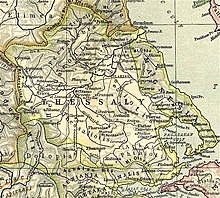
Thessaly
was home to extensive
Neolithic
and
Chalcolithic
cultures around 6000–2500 BC (see
Cardium Pottery
,
Dimini
and
Sesklo
).
Mycenaean
settlements have also been
discovered, for example at the sites of
Iolcos
,
Dimini
and
Sesklo
(near
Volos
). In Archaic and
Classical
times, the lowlands of Thessaly
became the home of baronial families, such as the
Aleuadae
of
Larissa
or the Scopads of Crannon. In the 4th
century BC
Jason of Pherae
transformed the region into a
significant military power, recalling the glory of Early Archaic times. Shortly
after,
Philip II of Macedon
was appointed Archon
of Thessaly, and Thessaly was thereafter associated with the Macedonian Kingdom
for the next centuries. Thessaly later became part of the
Roman Empire
as part of the province of
Macedonia
.
|










